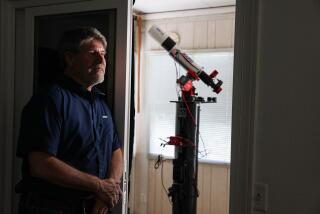Scientists chat live at noon on surprising starburst galaxies
- Share via
The world’s most powerful radio telescope helped show that the universe’s star-forming engines were revved up far earlier than once believed – before it was even fully built. That same telescope in the Chilean desert may soon also help scientists understand the detailed structure of dark matter in the universe.
Researchers who discovered the early abundance of what are known as starburst galaxies, described earlier this month in Nature, will be chatting about their findings at a Kavli Foundation Google hangout at 12 p.m. Pacific time Friday in the window above. (Ask questions via Twitter #KavliAstro or by emailing [email protected].)
The Atacama Large Millimeter Array, comprised of some 66 giant radio telescopes sitting in the Atacama desert, had its proverbial ribbon cut this month. But using just a third of the array before ALMA was fully operational, a team of scientists were able to pick out a handful of strange, bright objects in the sky that turned out to be starburst galaxies from early in the universe’s history.
The astronomers using the ALMA telescope took advantage of an effect known as “gravitational lensing,” when a massive object actually bends the light of an object behind it, magnifying that background light.
The researchers then looked at the light’s redshift – a measure of how much the light is being stretched as the universe expands – which would tell them how far, and thus how old, the galaxies were.
Starburst galaxies are galaxies caught in the dramatic growth spurt of star formation that takes place in young galaxies over a mere 100 million years or so. But the researchers found that these galaxies were cropping up far earlier than thought.
“That basically pushed the history of when their formation peaked by a billion years backwards, earlier in time,” said Joaquin Vieira, a Caltech observational cosmologist and co-author of the Nature study, who will be participating in the chat.
Using ALMA, that same effect of gravitational lensing could also help researchers map out the mass distribution of dark matter on slightly smaller scales in the universe, Vieira said. And based on how it clumps, they could figure out what the particles’ masses are. Clumpier dark matter would mean larger particles; more evenly distributed dark matter would mean smaller particles.
Follow me on Twitter @aminawrite.






